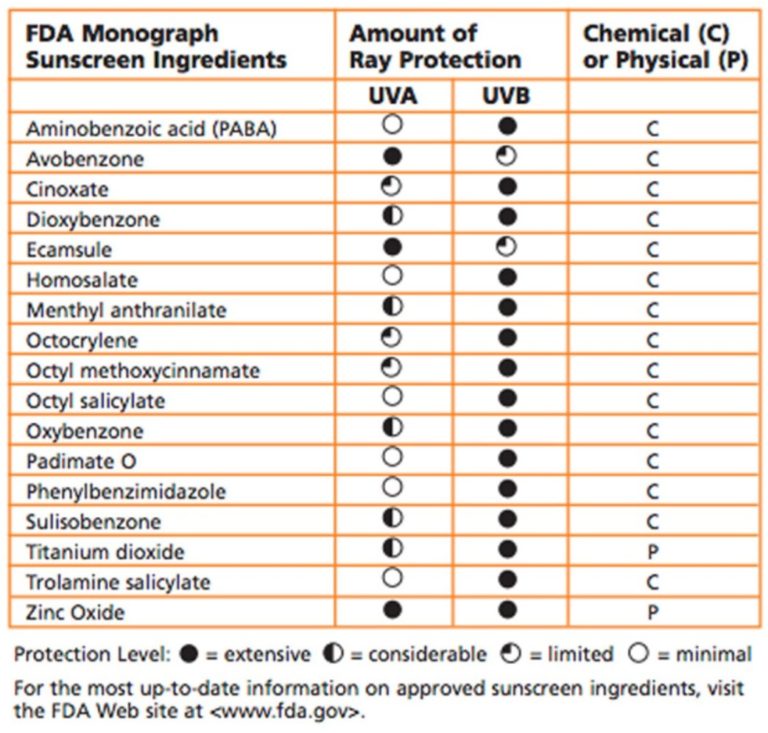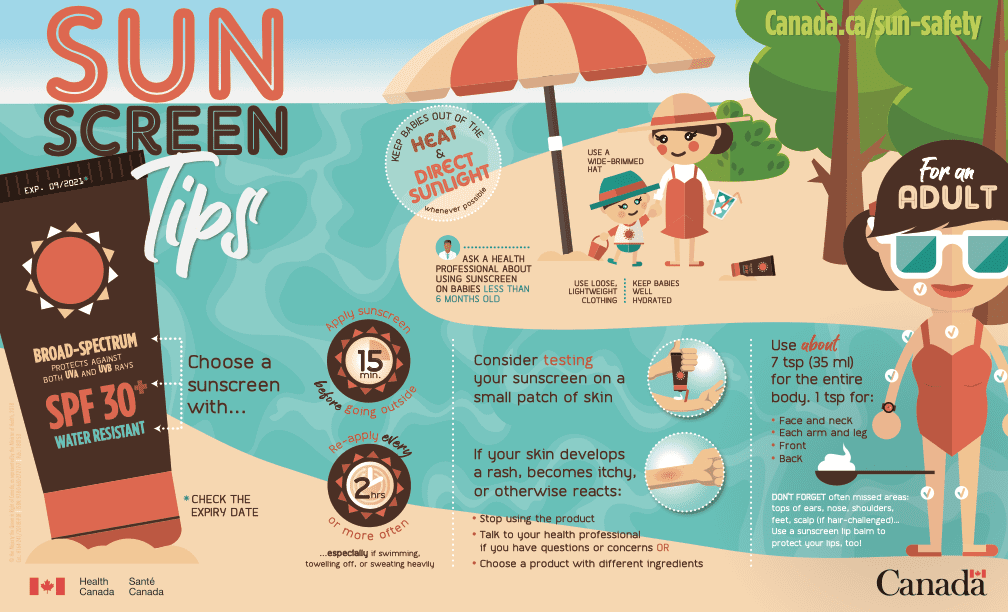
Sunscreen – What Is the Difference Between Physical & Chemical Variations?
What is Physical Sunscreen?
Physical sunscreens, sometimes referred to as mineral sunscreens, use mineral ingredients that have natural or passive sun protective properties. Some examples of these ingredients are titanium dioxide or zinc oxide.
What is Chemical Sunscreen?
Chemical sunscreens utilize chemical ingredients with active sun protective properties. Some examples of these ingredients are avobenzone, octinoxate and oxybenzone.
What is the difference?
Chemical sunscreen absorbs into the skin and then absorbs UV rays, converts the rays into heat, and releases them from the body. Physical sunscreens work by sitting on top of the skin to deflect damaging UV rays away from the skin.

What are the pros and cons of both?
Chemical Sunscreen
Pros:
- Less is needed to protect the skin because there is no risk of spaces between the sunscreen molecules after application
- Tends to be thinner and spreads more easily on the skin
- Can give great waterproof protection during swimming and activities where you may be very sweaty
Cons:
- Requires about 20 minutes after application before it starts to work
- Can lead to oxidative cell damage from inadequate UVA protection
- Increased chance of irritation and stinging due to the multiple ingredients combined in order to achieve broad spectrum UVA and UVB protection
- The higher the SPF, the higher the risk of irritation for sensitive skin types
- The protection it offers gets used up more quickly when in direct UV light, so re-application must be more frequent.
- May clog pores for oily skin types
- The ingredients can be absorbed by the body and have been found in the blood stream and milk of nursing mothers
- Some of the ingredients in chemical sunscreens are proven to be harmful to the environment, especially coral reefs in the oceans
Physical Sunscreen
Pros:
- Offers protection against both UVA and UVB rays and is naturally broad-spectrum
- Protects from the sun as soon as it’s applied, no wait needed
- Lasts longer when in direct UV light
- Less likely to cause a stinging irritation on the skin
- Less likely to be pore-clogging, making it ideal for acne-prone skin
- Longer shelf life
- The ingredients are not absorbed by the body, as the particle size of minerals in physical sunscreen is large
Cons:
- Can rub off, sweat off and rinse off easily, meaning more frequent re-application when swimming, sweating or doing physical activities
- May leave a white film on the skin, making some formulas incompatible for medium to dark skin tones, although many cosmetically elegant variations are available
- Needs to be applied and re-applied generously and accurately since UV light can get between the sunscreen molecules and get into the skin

How can I tell if sunscreen is physical or chemical?
You can determine the type of sunscreen by looking at the consistency and packaging. Chemical sunscreens are typically less thick and more transparent, while physical sunscreens will list zinc oxide and/or titanium dioxide in the ingredients. The UV filters typically found in the ingredient lists of chemical sunscreens are oxybenzone, avobenzone, octisalate, octocrylene, homosalate, and octinoxate.
In Canada, products containing one or more chemical UV filter will have an 8-digit drug identification number (DIN) on the label. Products containing only physical UV filters will have an 8-digit natural product number (NPN) on the label. If your sunscreen contains both chemical and physical filters, it will have an 8-digit drug identification number (DIN) on the label.
Which sunscreen ingredients are most protective against UV rays?
There are many ingredients available for use in both physical and chemical sunscreens, although not all of them are made equal.

The FDA’s sunscreen monograph shows how the available ingredients compare. Zinc oxide comes out on top!
How can I evaluate my sunscreen ingredients on my own?
Incredibly helpful smartphone apps, such as the Environmental Working Groups’ “EWG Healthy Living” app or the “Think Dirty” app, can be excellent resources for assistance with reviewing ingredients in sunscreens and other skincare, body, and household products – with just the scan of a specific products bar code.

Chemical vs. Physical Sunscreen: Is One Type Safer?
A small randomized clinical trial published in May 2019 in the Journal of the American Medical Association (JAMA) revealed that four sunscreen chemicals (avobenzone, oxybenzone, octocrylene, and ecamsule) are absorbed into the bloodstream at significantly greater levels than 0.5 nanograms per milliliter (ng/mL).
That’s far above the amount at which the FDA requires topical medications to undergo safety studies to determine possible toxic effects.
These results were echoed in a follow-up study published January 2020 in JAMA Journal of the American Medical Association, though this research looked at six sunscreen chemicals (avobenzone, oxybenzone, octocrylene, homosalate, octisalate, and octinoxate).
Although study authors say these results support the need for more research, they also say their findings don’t indicate that sunscreen is unsafe. What’s more, the known health risks of sun exposure far outweigh the potential risk of absorbing sunscreen chemicals.
Still, the Environmental Working Group (EWG) recommends avoiding chemical sunscreens with oxybenzone because of concerns that this ingredient may disrupt hormones and cause allergic skin reactions.
| Chemical | FDA 2019 proposed classification as safe and effective | Skin penetration | Hormone disruption | Skin allergy and or other concerns |
| Oxybenzone | No | + | + | + |
| Octinoxate (Octyl methoxycinnamate) | No | + | + | + |
| Homosalate | No | + | + | + |
| Octisalate | No | + | – | – |
| Octocrylene | No | + | – | + |
| Avobenzone | No | + | + | + |
| Titanium dioxide | Yes | – | – | Inhalation concerns |
| Zinc oxide | Yes | – | – | Inhalation concerns |
It is also cautioned against using chemical sunscreens when swimming in the ocean. A review published in January 2019 in the Journal of the American Academy of Dermatology found that common chemical sunscreen ingredients such as oxybenzone may bleach and damage coral reefs. For this reason, some tourist destinations, including Hawaii, have banned oxybenzone, as the Center for Biological Diversity notes.

Meanwhile, the ingredients in mineral sunscreens — zinc oxide and titanium oxide — have been generally recognized as safe and effective by Health Canada & the FDA.
What type of sunscreen is safest during pregnancy?
There are two ingredients that Health Canada & the FDA have established as generally safe for use by all people: zinc oxide and titanium dioxide. They’re natural minerals that physically block the sun’s harmful rays from getting to your skin.
Zinc oxide and titanium dioxide are the main ingredients in physical sunscreens, which are also known as mineral sunscreens.
Physical sunscreens, with mineral ingredients, are the best for children, pregnant or breastfeeding women, and those with sensitive skin as the ingredients tend to be gentler on the skin and are generally not absorbed or found in the blood stream after application.
What should I look for in sunscreen, regardless of if it is physical or chemical?
- Broad spectrum (protects from both UVA and UVB rays)
- Fragrance-free
- Noncomedogenic (won’t clog pores)
- Oil-free
- Paraben-free
- SPF (sun protection factor) of at least 30 or higher

What should be my one main takeaway regarding sunscreen?
Practicing safe sun safety to protect your skin from the sun’s harmful UV rays is essential. Whether the forecast calls for cloudy or sunny skies, sunscreen should be a fixture in your daily skincare routine, whether it be a physical or chemical variation.
With the known health risks of sun exposure far outweighing the potential risks of absorbing sunscreen chemicals, just ensure you ARE wearing a sunscreen daily and reapplying appropriately to protect your skin.



